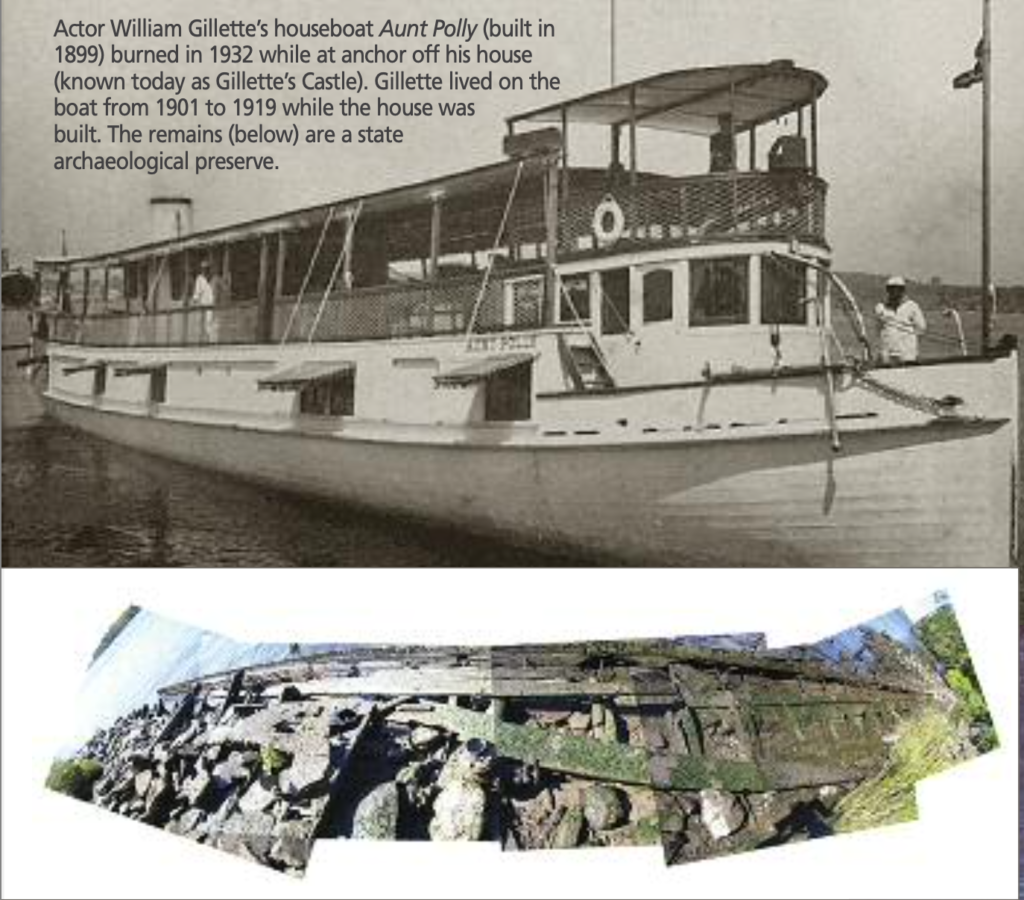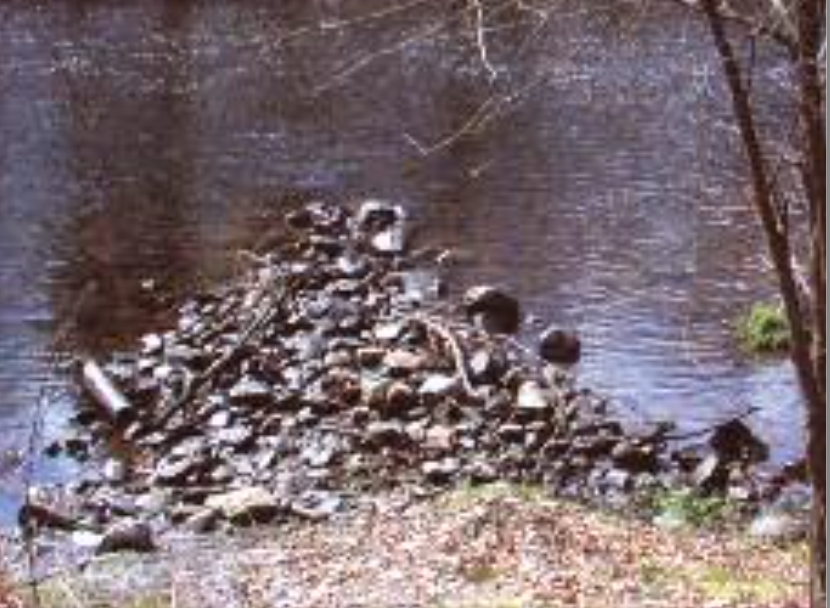
Actor William Gillette’s houseboat Aunt Polly (built in 1899) burned in 1932 while at anchor off his house (known today as Gillette’s Castle). Gillette lived on the boat from 1901 to 1919 while the house was built. The remains are a state archaeological preserve. Courtesy State Historic Preservation Office, DECD
By Karin Peterson
(c) Connecticut Explored Inc. Summer 2014
Subscribe/Buy the Issue!
What do the underwater remains of William Gillette’s yacht, the Aunt Polly, have in common with an archaic Native American fishing site in Killingly? Both are state-designated archaeological preserves.
Connecticut’s State Historic Preservation Office (SHPO) is not only charged with the oversight of the state’s heritage above ground but also below. The legal classification “archaeological preserve” was proposed by the SHPO and the Office of State Archaeology (OSA) at the University of Connecticut to provide protection for the state’s least recognized historical resource, its archaeological sites. The designation was officially established by legislation in 2000 with a statute that sets penalties for vandalism or unlawful collecting of archaeological remains. Varying legal means are used by other states to safeguard archaeological sites; Connecticut alone creates preservation zones.
Cathy Labadia, the newly appointed SHPO staff archaeologist, and State Archaeologist Nicholas Bellantoni (See “Right Down the Street and Right Beneath Your Feet”) work with the archaeological community, concerned citizens, and property owners to identify and assess areas of archaeological significance. SHPO and the OSA maintain information on more than 5,500 such sites within the state. Any site may be nominated as a state archaeological preserve; the special designation is conferred by the Historic Preservation Council after an application process that includes opportunity for public comment. Before any ground disturbance may take place on an archaeological preserve, formal permission must be obtained from the SHPO. SHPO may require test units to be dug in areas that will be affected by any planned work and/or specify that an archaeologist be present to monitor the excavation work to identify and record any features that are revealed.
The Cady-Copp House in Putnam, owned by Aspinock Historical Society, typifies one form of archaeological preserve. The house has changed little since its construction in 1745, and the preserve designation protects the history concealed and as yet undisturbed in the surrounding landscape.
The remains of past industrial activity, below or above ground, may also need to be safeguarded. The most unusual, and biggest, archaeological preserve is the Air Line Railroad Archaeological District located in Colchester and East Hampton. The Air Line Railroad, which opened in 1873, connected New Haven and Willimantic, and at each terminus passengers could catch other trains to proceed to New York City or Boston. Two wrought-iron viaducts, considered engineering marvels, were built to accommodate the hilly terrain. Although passenger service stopped in 1902, the line continued to be used for freight. To accommodate heavier loads, in 1912-1913 valleys were filled in with hopper-car load after hopper-car load of sand, totally entombing the viaducts. The rail line was fully abandoned by 1964. The linear preserve consists of the railroad right of way, the two buried viaducts, and two bridges.
An archaeological preserve may have no structures or any overt visible remains. One example is the Aunt Polly, whose burned carcass lies on the bottom of the Connecticut River. In other cases, the physical evidence above ground may be ambiguous. Only scattered rocks, a common sight through the state, remain of the homestead of self-emancipated Venture Smith in East Haddam, and the camp in Bolton used by French troops crossing the state under General Rochambeau to meet up with Washington at Yorktown, yet both are designated preserves.

Remnants of a stone weir extending into the Quinebaug River, Lebeau Fishing Camp and Weir State Archaeological Preserve, Killingly. More than 8,700 aboriginal artifacts were recovered, showing it was in use for 6,000 to 8,000 years. Courtesy State Historic Preservation Office, DECD
It also takes an expert to identify the lines of stones in the Quinebaug River in Killingly as the remnant of a Native American fishing weir. The site is the oldest known example of this technology in Connecticut, and the wide date range and variety of recovered cultural materials indicate that the weir and nearby seasonal camp were used by archaic peoples for a long time. The earliest diagnostic artifact documents the presence of Native Americans here 8,000 to 6,000 years ago, and the site saw continued use until 4,500 to 1,500 years ago.
Karin Peterson is museum director for the Connecticut Department of Economic and Community Development.
Explore!
“Gillette Castle: Home of Connecticut’s Sherlock Holmes” Spring 2015
“Sites Underwater Worth Preserving, Too,” Spring 2009
“Destination: The Air Line State Park Trail’s Lyman Viaduct,” Summer 2008
Read all of our stories about Native Americans in Connecticut on our TOPICS page
State Archaeological Preserves
To date Connecticut has 31 preserves.
- Putnam Memorial State Park (Redding & Bethel)
- Axle Shop-Spring Factory Archaeological Site (Hamden)
- Kent Iron Furnace (Kent)
- New Gate Prison & Copper Mine (East Granby)
- Fifth Camp of Rochambeau’s Infantry (Bolton)
- Fort Wooster Park (New Haven)
- Fourth Camp of Rochambeau’s Army (Windham)
- Small Pox Hospital Rock (Farmington)
- New London Engine House & Turntable (New London)
- Quinebaug River Prehistoric Archaeological District (Canterbury)
- Aunt Polly (East Haddam)
- Cornfield Point Light Ship LV51 (Old Saybrook)
- Bridgeport Wood Finishing Company (New Milford)
- John Brown Birthplace (Torrington)
- Air Line Railroad Archaeological District (Colchester & East Hampton)
- Governor Samuel Huntington Homestead (Scotland)
- Cady-Copp House Archaeological Site (Putnam)
- World War II “Hellcat”[?] Sites, Putnam
- Henry Whitfield State Museum (Guilford)
- Dividend Brook Industrial Archaeological District, Rocky Hill
- Fort Griswold State Park (Groton)
- Ebenezer Story Homestead and Tavern (Preston)
- Fort Stamford (Stamford)
- New England Hebrew Farmers of the Emanuel Society Synagogue and Creamery Archaeological Site (Montville)
- Prudence Crandall Museum (Canterbury)
- LeBeau Fishing Camp & Weir (Killingly)
- Barkhamsted Lighthouse Site (Barkhamsted)
- Civilian Conservation Corps Camp Filley (Haddam)
- Pine Island (Groton)
- Ash Creed Corduroy Road (Fairfield)
- West Parish Meeting House (Westport)

